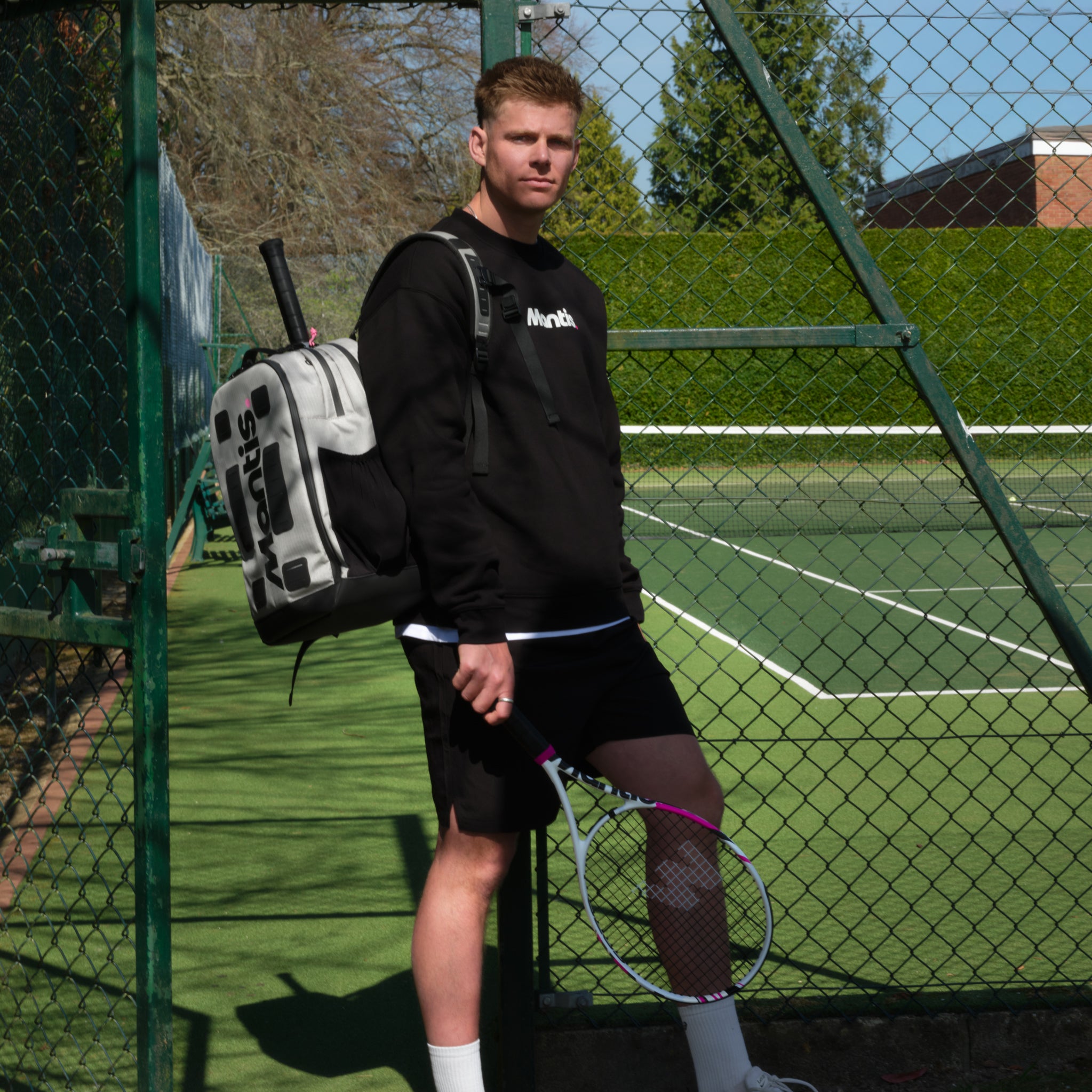
Here at Mantis, we see it all the time: a player’s game has simply outgrown their gear. The right intermediate tennis racket is the one that rewards all that hard work you’ve put in, giving you a blend of power and feel that a beginner frame just can't offer. Making the switch is one of the most important steps you’ll take to unlock your real potential. At Mantis, we believe that understanding your equipment is crucial for development, which is why we've put together a detailed guide to understanding tennis racket specifications.
Why Your Beginner Racket Is Holding You Back
If you’re still swinging the first racket you ever bought, there's a good chance it's the very thing limiting your progress. Beginner rackets are designed with one goal in mind: making it as easy as possible to get the ball over the net. They usually have oversized heads (105+ sq. inches) and are incredibly light, which is perfect for helping new players make contact and fall in love with the game.
But the very features that made that racket so forgiving are now becoming roadblocks. That massive head size gives you a huge sweet spot, but it comes at the cost of precision—something you now need to start hitting targets and building points. As your swing gets faster and more confident, you'll probably find the ball sailing long because you lack the control a smaller head provides. This can even force you to shorten your swing, which is the last thing you want when developing full, fluid strokes.
The Limits of Forgiveness
The light weight of a beginner frame also becomes a liability as you improve. It might be easy to swing, but it just doesn’t have the mass to stand up to powerful shots coming from your opponent. You might feel the racket twisting in your hand when you’re returning a heavy serve or feel it get pushed around during a fast-paced rally. That instability means a loss of both control and power, right when you need them most.
A proper intermediate racket solves these problems directly. Here’s what you stand to gain by upgrading:
- More Stability: A bit of extra weight gives you what players call "plough-through." The racket drives through the ball with authority instead of being knocked back by it.
- Better Control and Feel: With head sizes typically between 98-102 sq. inches, these frames give you the precision to aim for the corners and start pulling off more advanced shots.
- Access to More Spin: Intermediate rackets are built to work with the faster swing speeds you’re developing, helping you generate the heavy topspin that defines the modern game.
At Mantis, we believe your equipment should grow with you. Moving from a beginner to an intermediate frame is perhaps the most important gear decision a developing player will make. It's about choosing a tool that supports your ambition, not one that restricts it.
Ultimately, holding onto that beginner racket means you're playing with a tool that no longer fits your game. Making the switch isn't just buying new gear; it's an investment in your own improvement.
Decoding Specs of Your Intermediate Tennis Racket
Choosing a good intermediate tennis racket means learning a new language—the language of numbers and specifications. At Mantis, we want to translate those specs into real on-court performance, helping you see how each number actually affects your shots. The choice of materials is also a critical factor in how a racket performs, a topic we cover in our guide to tennis racket materials.
This visual shows the natural progression from a basic beginner frame to a more performance-oriented intermediate racket as your skills advance.
The key insight here is that your racket should evolve with your game. The frame that got you started will eventually start to hold you back.
Head Size: The Blend of Forgiveness and Precision
The head size is the first spec most players notice. While beginner frames often feature massive, oversized heads (105+ sq. inches) for a huge sweet spot, intermediate rackets usually dial this down.
Most developing players find their sweet spot in the 98-102 sq. inch range. A 100 sq. inch head, for example, offers a brilliant blend of power and control. It's forgiving enough for those off-centre hits but gives you the precision needed to start aiming for the lines, not just the middle of the court.
Racket Weight: Finding Stability and Swing Speed
Weight is perhaps the most critical factor for an intermediate player. It directly impacts stability, power, and how the racket feels after an hour of play. Moving from a super-light beginner frame to one with more substance is a big step up.
An ideal strung weight range for an intermediate racket sits between 300g and 320g. This added mass provides "plough-through," letting the frame drive through the ball instead of getting pushed around by heavy shots from your opponent.
A racket in this range feels stable on returns and solid at the net, yet it's still light enough for you to generate the racket head speed you need for modern topspin and power.
Choosing the right weight is a balancing act. The goal is to find the heaviest racket you can comfortably and consistently swing fast for an entire match without your technique breaking down from fatigue.
The broader UK tennis market reflects this demand for performance-oriented gear. The UK tennis equipment market is projected to reach $227.12 million by 2035, driven partly by players like you seeking advanced materials that make rackets both stable and easy to manoeuvre.
This growth shows that intermediate players are benefiting from technologies that were once only found in professional frames.
Racket Balance: The Feel in Your Hand
Finally, balance determines how that weight is distributed. Most intermediate rackets are either evenly balanced or slightly head-light, meaning more of the weight is shifted towards the handle.
A head-light balance makes a racket feel quicker in the hand and much easier to manoeuvre. This is a massive advantage for quick reflex volleys at the net or whipping the racket head up and over the ball for a kick serve.
This characteristic helps players generate faster swings, which is the key to creating modern, heavy topspin. Ultimately, finding a frame that feels balanced in your hand will give you the confidence to execute every shot in your arsenal.
Intermediate Racket Spec Cheat Sheet
Getting your head around all the numbers can be a lot. This table is a quick reference guide to help you translate the specs on the side of a racket into what you’ll actually feel on the court.
| Specification | Typical Range (Intermediate) | On-Court Effect | Best For Player Who... |
|---|---|---|---|
| Head Size | 98–102 sq. in. | A balanced mix of power, forgiveness, and control. | Wants to add precision without sacrificing the sweet spot. |
| Weight | 300g–320g (strung) | Adds stability, "plough-through," and power. | Is ready to handle more mass for solid, penetrating shots. |
| Balance | Even to Head-Light | Feels quick and easy to manoeuvre at the net. | Needs to generate more racket head speed for spin and power. |
Think of these specs as a starting point. The perfect racket for you will feel like an extension of your arm, giving you the confidence to go for your shots without hesitation.
Matching a Racket to Your Playing Style
The best intermediate tennis racket isn't a single model; it’s the one that feels like a natural extension of your game. At Mantis, we believe figuring out your on-court identity is the most critical step in finding the right frame. Once you've zeroed in on a racket, it's also worth learning about the different tennis racket materials to fully understand its feel and performance.
So, who are you on the court? Are you an aggressive baseliner, looking to dictate points with heavy, high-bouncing shots? Or do you see yourself as more of an all-court player, using variety and quick transitions to the net to keep your opponent off balance? Your answers will point you directly to the specifications that will make your game sing.
The Aggressive Baseliner
So much of the modern game is won from the back of the court. Players who thrive here use relentless depth and heavy topspin to push their opponents into defensive positions before unleashing a winner.
If this sounds like you, your racket needs to support that powerful, fast swing. Look for frames that are:
- Slightly heavier: A strung weight between 305g and 320g gives you the stability and "plough-through" you need to drive the ball deep, even when you’re under pressure.
- Head-light: A head-light balance makes a heavier frame feel much faster through the air. This helps you generate the explosive racket head speed essential for creating that heavy, kicking topspin.
- More flexible: A lower stiffness rating (RA) can increase the time the ball stays on the strings—often called "dwell time"—giving you a better feel and more control over your spin-heavy shots.
A baseliner’s game is built on rhythm and repetition. The right racket makes it feel almost effortless to hit your targets rally after rally, letting you patiently wait for the perfect opportunity to attack.
The All-Court Player
All-court players are the strategists of the tennis world. They’re perfectly comfortable trading groundstrokes from the baseline, but they're always hunting for a chance to move forward, whether it’s with a clever slice approach shot or by serving and volleying.
For this versatile style, you need a racket that can do a little bit of everything. Your frame should feel quick in your hands, stable on impact, and responsive to your commands.
Key characteristics for the all-court player include:
- Moderate weight: A strung weight around 300g to 310g offers a great blend of stability for groundstrokes and manoeuvrability for those quick-fire volleys at the net.
- Even balance or slightly head-light: This balance point provides a solid feel on groundstrokes without sacrificing the quick reactions needed to handle fast-paced exchanges up close.
- Mid-range head size: A 98 or 100 sq. inch head provides a fantastic combination of control for precise volleys and a forgiving enough sweet spot for your groundstrokes.
Your playing style is your tennis DNA. A good intermediate racket doesn't try to change it; it amplifies it. The goal is to find a frame that makes your best shots even better and your game plan easier to execute.
For deeper industry analysis on how different racket types are trending, the team at racketbusiness.com provides excellent market insights. Ultimately, the perfect match is a racket that feels intuitive from the first hit, giving you the confidence to play your game, your way.
Frame Materials and String Patterns: The Feel Behind the Numbers
Beyond the headline specs like weight and head size, the materials and string layout are what truly define a racket's personality on court. At Mantis, we know the science behind the frame is just as important as the numbers. Our detailed guide on tennis racket materials is worth exploring if you want to make a properly informed choice.
Most modern performance rackets are built from graphite composites. Graphite itself gives you that fantastic blend of stiffness, stability, and lightness—the foundation for both power and control. But manufacturers often blend it with other materials like carbon fibre, fibreglass, or even basalt to fine-tune how the racket feels at impact.
Frame Composition and Feel
A racket that’s "100% Graphite" might feel powerful and crisp, giving you sharp feedback on every shot. Another one that incorporates more flexible materials could offer a plusher, more comfortable response. This creates more "dwell time"—that feeling of the ball sinking into the strings—which is a huge plus for players who value feel or have dealt with arm issues in the past.
It's clear players are looking for this kind of technology. The UK tennis racket market recently hit a value of $62 million, a trend driven by players wanting better gear. This really shows that more and more people, especially improving intermediates, realise the right racket can make a massive difference.
String Patterns and Your Shots
The string pattern is the final piece of this puzzle. It’s simply the number of main (vertical) and cross (horizontal) strings, and it directly affects your spin potential and control. For intermediate rackets, you'll almost always see two main options: 16x19 and 18x20.
-
Open Pattern (16x19): This is by far the most popular choice for intermediate players, and for good reason. With fewer strings, there’s more space between them. This lets the strings bite into the ball and snap back into place, generating some serious topspin. It also creates a higher launch angle, helping your shots clear the net with a bit more margin for error.
-
Dense Pattern (18x20): This pattern packs more strings into the same head size. The result is a firmer, more controlled response. It's usually favoured by players who hit a flatter ball and value pinpoint precision over heavy spin. The lower launch angle gives you a more direct ball trajectory, rewarding those with clean, consistent technique.
Choosing a string pattern is really about matching the racket's engine to your playing style. An open pattern helps you shape points with spin, while a dense pattern lets you direct the ball with surgical accuracy.
Think of it this way: a 16x19 pattern is like having wider grooves on a tyre for better grip in today's spin-heavy game. An 18x20 is more like a racing slick, offering maximum contact and control for precise, flat hitting. Neither is better than the other—they just support different ways of playing tennis.
How to Properly Demo Your Next Racket
Reading a spec sheet is one thing, but you only truly find out if a frame is right for you by hitting with it. At Mantis, we believe the demo process is where your research meets reality, turning theory into on-court confidence. For those looking to dive deeper into the technical side, we recommend our comprehensive guide to understanding tennis racket specifications.
Before you even step on the court, it pays to have a plan. The market has exploded recently; in 2021, the UK saw a remarkable 76% year-on-year rise in racket sales, part of a much wider European trend. That means more choice for players, making a structured demo process crucial to cut through the noise.
First thing’s first: narrow down your options. Based on the specs that seem to fit your game, pick two or three different frames to test. Trying to demo any more than that usually just leads to confusion, as all the subtle differences start to blur together.
Creating a Consistent Testing Environment
To get a true side-by-side comparison, you have to control the variables. This is a big one.
Ask your local pro shop or stringer to put the same type of string in all your demo rackets, strung at the exact same tension. A quality synthetic gut is a great baseline for most intermediate players, offering a nice blend of feel, power, and comfort.
This step ensures you're feeling the differences in the frames themselves, not the strings. A racket strung with a stiff polyester will feel completely different from the very same frame strung with a soft multifilament. Consistency here is absolutely key.
Your On-Court Demo Checklist
Once you're on court, resist the urge to jump straight into a match. Instead, run each racket through a structured hitting session to see how it performs across a range of situations. A proper test should cover every part of your game.
Try to work through this kind of progression with each frame:
- Groundstrokes: Kick things off with some simple cross-court rallies. Really focus on how the racket feels on both your forehand and backhand. Does it feel stable when pace comes at you? Can you generate enough depth and spin without feeling like you have to over-swing?
- Serves: Hit all your serves—flat, slice, and kick. Pay close attention to how easily you can generate racket head speed and whether you feel you can place the ball where you want it.
- Returns: Get a partner to hit serves at you. The racket should feel solid and not twist in your hand, especially on those off-centre returns that are so common in a real match.
- Volleys and Net Play: Test your reactions up at the net. A good intermediate racket should feel manoeuvrable enough for quick exchanges but still have enough stability to punch volleys deep into the court.
The goal is to find a racket that feels like an extension of your arm—one that performs predictably across all your shots and gives you the confidence to just play freely.
Finally, think about comfort over a longer hitting session. A racket that feels amazing for the first twenty minutes might start to feel harsh or heavy after an hour of play. The best choice is almost always the one that still feels good in your hand during the final minutes of a tough practice or a long match.
Got Questions? We’ve Got Answers
As you narrow down your options, a few questions always pop up. Here at Mantis, our goal is to give you clear, honest answers so you can pick your next frame with total confidence. After all, getting this choice right is a massive step in your journey. For deeper dives into the latest gear talk, we're big fans of the insights over at racketbusiness.com.
How Often Should I Be Replacing My Racket?
If you're an intermediate player hitting the court 2-3 times a week, you should start thinking about a new frame every two to three years. It's not just about the racket getting old; it's about you getting better.
Think about it: after thousands of shots, the composite materials inside a frame naturally lose some of their pop. That's when you get that 'dead' feeling—a noticeable drop in power and a lot more vibration travelling up your arm.
But more importantly, the player you are today is not the same player you were two years ago. Your swing has evolved, and your racket needs to keep up. A good intermediate tennis racket should be a partner for your current game, not a reminder of your old one.
Should I Go for a Heavier or Lighter Frame?
This really comes down to a trade-off between your physical strength and your swing style. There’s no magic number, but there are some solid principles to guide you.
- A heavier racket (think 300-320g strung) is your friend when it comes to stability and power. It plows through the ball beautifully, but only if you have the technique to generate your own racket head speed without forcing it.
- A lighter frame (closer to 280-300g strung) is much easier to whip through the air. This makes it a great tool for generating spin and gives you that extra bit of manoeuvrability for quick-fire reactions at the net.
The rule of thumb we often share at Mantis is this: choose the heaviest racket you can comfortably swing for a full match without your technique falling apart from fatigue.
Does the Brand of Racket Really Matter?
Honestly, the specs are far more important than the logo painted on the side. While every major brand makes fantastic rackets, getting fixated on one can seriously limit your options and cause you to miss out on a frame that’s a perfect match for your game.
The things that truly count are weight, balance, head size, and stiffness. Our advice is always to find the specs that complement your style first. Once you've got those numbers locked in, demo a few frames with similar specs from different brands.
This approach ensures you find a racket that genuinely feels like an extension of your arm, giving you the confidence to go out and play your best tennis.
Mantis believes in performance without pretension. Our rackets are expertly crafted for players who live for progress, offering a direct-to-consumer model that focuses on quality, not hype. Find the frame that matches your ambition. https://mantissport.com










